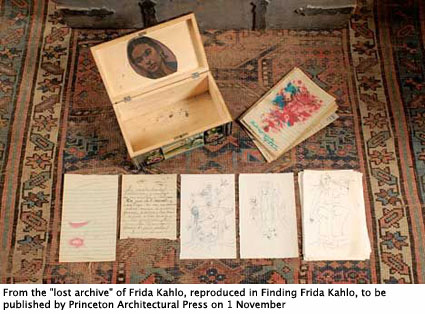Forthcoming Frida Kahlo book denounced as fake
by Jason Edward Kaufman
The Art Newspaper
20 August 09
Art historians assert that “lost archive” of paintings, drawings and diaries are forged
 New York. A collection of Frida Kahlo oil paintings, diaries and archival material that is the subject of a book to be published by Princeton Architectural Press on 1 November has been denounced by scholars as a cache of fakes. Finding Frida Kahlo includes reproductions of paintings, drawings and handwritten letters, diaries, notes, trinkets and other ephemera attributed to the artist. They belong to Carlos Noyola and Leticia Fernà¡ndez, a couple who own the antique store La Buhardilla Antiquarios in San Miguel de Allende, Mexico. The publisher describes it as “an astonishing lost archive of one of the twentieth century’s most revered artists…full of ardent desires, seething fury, and outrageous humor”.
New York. A collection of Frida Kahlo oil paintings, diaries and archival material that is the subject of a book to be published by Princeton Architectural Press on 1 November has been denounced by scholars as a cache of fakes. Finding Frida Kahlo includes reproductions of paintings, drawings and handwritten letters, diaries, notes, trinkets and other ephemera attributed to the artist. They belong to Carlos Noyola and Leticia Fernà¡ndez, a couple who own the antique store La Buhardilla Antiquarios in San Miguel de Allende, Mexico. The publisher describes it as “an astonishing lost archive of one of the twentieth century’s most revered artists…full of ardent desires, seething fury, and outrageous humor”.
According to an interview in the forthcoming book, and to emails from Noyola to The Art Newspaper, the couple acquired the items incrementally from 2004-07 from a lawyer who in turn had acquired them from a woodcarver who allegedly received them from the artist. Noyola tells The Art Newspaper he has more than 1,200 Kahlo items in all. He would not disclose how much he paid, but says: “We did acquire the collection with the belief and some groundwork done to prove that it is in fact authentic and thus paid accordingly.” He states that the collection is not for sale and will not be for sale in the future.
The author of the 256-page illustrated book is Barbara Levine, a former director of exhibitions at the San Francisco Museum of Modern Art who operates a curatorial services company called Project b. She brought in as a secondary author Stephen Jaycox of San Francisco, with whom she has worked on archive and library exhibitions.
In an email to The Art Newspaper, Levine says that she is “not working for the Noyolas and the Noyolas did not fund any portion of the book”. She describes Finding Frida Kahlo as “my personal encounter with the materials”, and says that the study is “about the personal belongings of an icon not from the point of view of telling her story or contributing to her place in art history, but instead from the perspective of our essential human need to accumulate talismans, keep scraps to remember, track time and leave legacy”.
“If I had made an art historical book about Kahlo or set out to prove the authenticity of the Noyola collection it would have been appropriate for me to consult with Frida Kahlo experts,” she says, adding that experts”™ rejection of the collection is “understandable” because “art forgeries are common and historical discoveries are hard to believe when they occur outside of an institutional context”. She adds: “I have the highest regard and appreciation for the authorities on Frida Kahlo and understand it may take years to fully evaluate each piece in the Noyola collection in order to thoroughly reconcile authenticity, fact, and fiction.”
“In my view the publishers have been the victims of a gigantic hoax,” says New York-based Latin American art dealer Mary-Anne Martin, who has bought and sold numerous works by Kahlo (1907-54). “The perpetrators have constructed all these letters, poems, drawings and recipes, using Frida’s biography and her published letters as a roadmap. The drawings are badly done, the writing infantile, the content crude; the anatomy drawings look like something from a butcher shop instruction book. The paintings are “˜pastiches”™, composites based on published works. The provenance provided is unverifiable and meaningless. There”™s nothing I would like more than to discover a group of unknown works by Frida Kahlo, but there is no way on earth that any of these works could pass muster at Sotheby”™s, Christie”™s, or my gallery. I am astounded it has gone as far as it has.”
According to a statement from Princeton Architectural Press: “These doubts are explored directly in the book, including a lengthy interview with the owners of the store and collection, the Noyola family, who believe, based on analyses by a chemical engineer and a graphologist, as well as interviews with members of the Kahlo family and some of her followers and students, that the materials in the cases are legitimate.”
The supposed trove has been known since December 2005, when a painting of a Kahlo-headed deer (based on a well-known work by the artist) and four other alleged Kahlo paintings were “discovered” in Mexico and said to be among 283 related items. Several Mexican art historians and collectors declared the works false””Raquel Tibol told the press at the time that had this occurred in England, any person who made the fakes, sold them and owned them would be subject to prosecution.
Read the rest of this article here.
